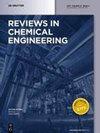将温室气体物种转化为增值化学品的环境足迹和影响:综述
IF 6.6
3区 工程技术
Q1 ENGINEERING, CHEMICAL
引用次数: 1
摘要
摘要本文评估了使用捕获的温室气体(GHG)作为化学合成原料的各种方法。分析主要关注两种最丰富的人为温室气体,如二氧化碳(CO2)和甲烷(CH4),以及它们获得甲醇(MeOH)、甲酸(FA)和碳酸二甲酯(DMC)的转化技术。将这些GHG转化为化学品技术与基于化石原料的传统工业方法进行了比较。概述了基本信息,如能源需求范围、环境足迹和经济生产方面。根据收集到的信息和分析,传统的非温室气体转换方法在环境上更具可持续性。基于CO2的化学品生产技术,如直接催化合成以获得MeOH和FA,以及与MeOH进行酯交换以获得DMC,是在将提供良好的共反应物来源(如氢气、碳酸亚乙酯和尿素)时大规模实施的相对好的候选者。反过来,合成目标化学品的电化学方法不太可行,因为与产品的浓缩和纯化阶段相关的能量消耗是主要热点。基于捕获的CH4的化学合成目前难以评估,因为可获得的信息太少,无法得出可信的结论。然而,这可能是未来的一种趋势。基于GHG的转化应用的局限性与捕获和运输阶段有关。本文章由计算机程序翻译,如有差异,请以英文原文为准。
Environmental footprints and implications of converting GHG species to value-added chemicals: a review
Abstract This paper assesses various approaches that use captured greenhouse gases (GHG) as feedstocks for chemical synthesis. The analysis focuses mainly on the two most abundant anthropogenic GHG, such as carbon dioxide (CO2) and methane (CH4), as well, their conversion technologies to obtain methanol (MeOH), formic acid (FA) and dimethyl carbonate (DMC). These GHG conversions to chemicals technologies are compared with the conventional industrial methods based on fossil feedstocks. The essential information, such as the ranges of energy requirements, environmental footprint and economic production aspects, are summarised. According to the collected information and analysis, the conventional, non-GHG conversion methods are still more environmentally sustainable. Chemicals production technologies based on CO2, such as direct catalytic synthesis to obtain both MeOH and FA, as well as transesterification with MeOH to obtain DMC, are relatively good candidates for implementation on a large scale when a good source of co-reactants such as hydrogen, ethylene carbonate and urea will be provided. In turn, electrochemical methods to synthesise the target chemicals are less feasible due to energy consumption related to the concentration and purification stages of products being the main hotspots. Chemical synthesis based on captured CH4 is currently difficult to evaluate as too little information is available to draw a credible conclusion. However, it may be a trend in future. The limitations of GHG-based conversion for application are related to the capture and transport stages.
求助全文
通过发布文献求助,成功后即可免费获取论文全文。
去求助
来源期刊

Reviews in Chemical Engineering
工程技术-工程:化工
CiteScore
12.30
自引率
0.00%
发文量
37
审稿时长
6 months
期刊介绍:
Reviews in Chemical Engineering publishes authoritative review articles on all aspects of the broad field of chemical engineering and applied chemistry. Its aim is to develop new insights and understanding and to promote interest and research activity in chemical engineering, as well as the application of new developments in these areas. The bimonthly journal publishes peer-reviewed articles by leading chemical engineers, applied scientists and mathematicians. The broad interest today in solutions through chemistry to some of the world’s most challenging problems ensures that Reviews in Chemical Engineering will play a significant role in the growth of the field as a whole.
 求助内容:
求助内容: 应助结果提醒方式:
应助结果提醒方式:


